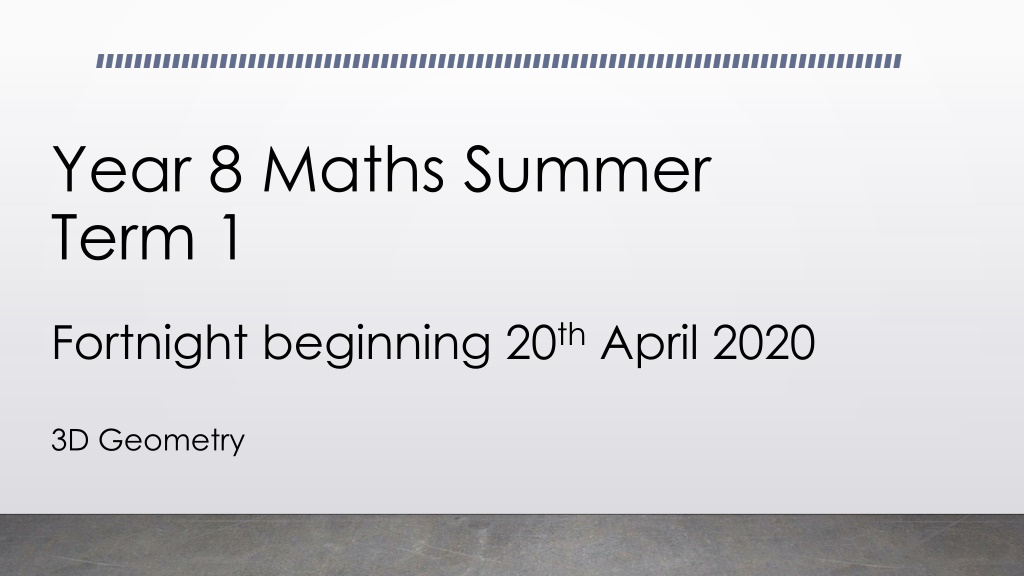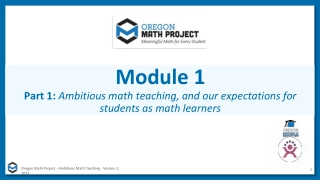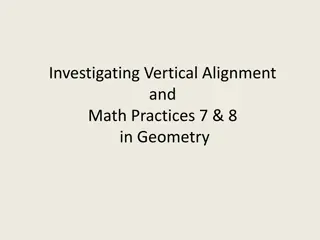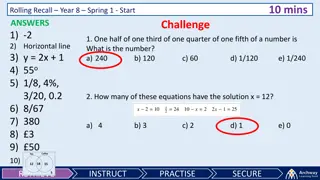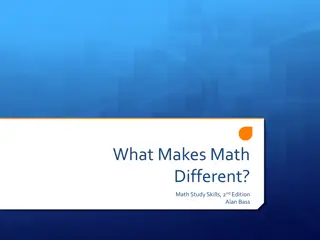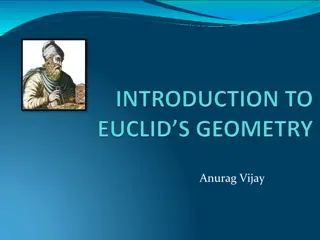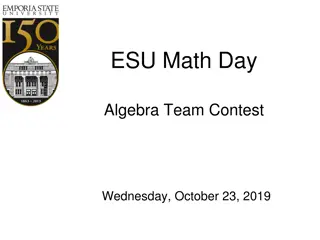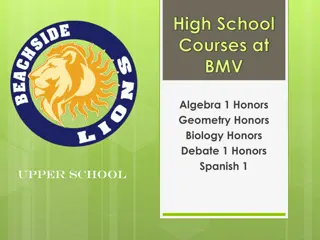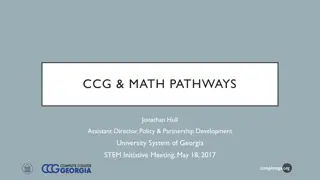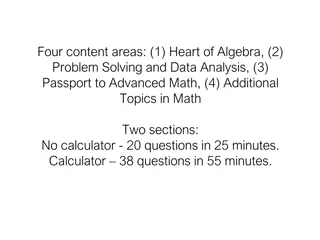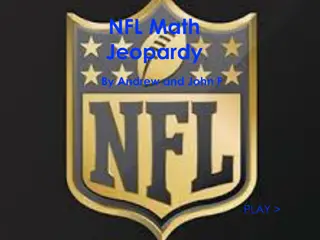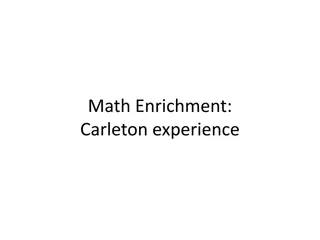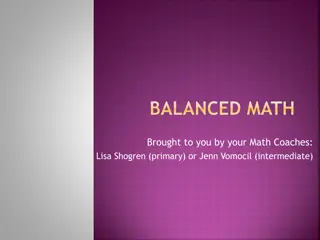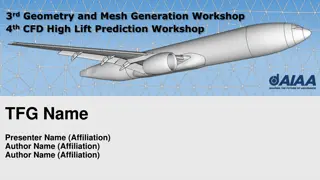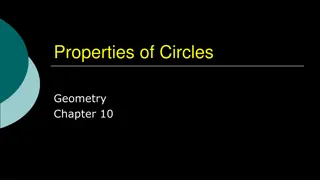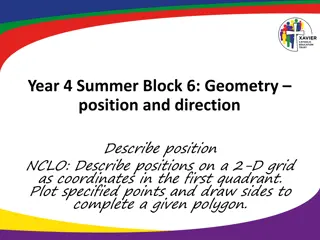Math Lessons Overview for Year 8 - Summer Term 1 Geometry
Explore the structured math lessons for Year 8 students focusing on 3D geometry. Tasks include drawing shapes, completing multiplications, and understanding plans and elevations. Engage with the content through online resources and practical exercises to enhance mathematical skills.
Download Presentation

Please find below an Image/Link to download the presentation.
The content on the website is provided AS IS for your information and personal use only. It may not be sold, licensed, or shared on other websites without obtaining consent from the author.If you encounter any issues during the download, it is possible that the publisher has removed the file from their server.
You are allowed to download the files provided on this website for personal or commercial use, subject to the condition that they are used lawfully. All files are the property of their respective owners.
The content on the website is provided AS IS for your information and personal use only. It may not be sold, licensed, or shared on other websites without obtaining consent from the author.
E N D
Presentation Transcript
Year 8 Maths Summer Term 1 Fortnight beginning 20thApril 2020 3D Geometry
Lesson Overviews how maths lessons will work for now Log into www.completemaths.com and complete the multiplication tables. Click on Quiz Me Complete 20 multiplication questions.
Lesson Overviews how maths lessons will work for now Click on the lesson shown Open the task set and complete the work on paper.
Lesson Overviews how maths lessons will work for now Each lesson will follow this structure Task 1) Complete 20 multiplications Task 2) Knowledge Organiser work or recall task for this lesson Task 3) Main task from classwork on complete maths to be uploaded to learning diary A copy of this terms knowledge organiser is at the end of this PowerPoint
Lesson Overviews how maths lessons will work for now Once completed, upload the completed task to your learning diary. Take a photo of the work and upload the file You can also start a conversation with me if you have any problems.
Lesson 1 Draw 3D shapes Task 1) Complete 20 multiplications Task 2) Sketch this cube from your knowledge organiser Task 3) Print the worksheet if possible, if not you can still participate with squared, lined, or plain paper. On the worksheet, there is already 1 cube drawn. Your task - have a go at drawing shapes with these volumes. a. 4 cubes b. 8 cubes c. 12 cubes d. 16 cubes You do not have to draw a symmetrical shape. The most adventurous shapes will receive a positive point. Upload the task to your learning diary.
Task 1) Complete 20 multiplications Lesson 2 Plans and elevations Task 2) Make flashcards for plan, elevation, and compound shapes from your knowledge organiser. Task 3) Watch the video assigned to your classwork and then answer these question. - What are the terms we can use for side 1 and side 2? (shape 1) - In your own words, what is the difference between a plan and an elevation? (knowledge organiser to help) (shape 1) - Explain why you cannot see the depth for the plan view? (shape 2) - Why is the plan straight when the elevation is slanted? (shape 3) Upload your answers to your learning diary
Task 1) Complete 20 multiplications Lesson 3 Plans and elevations Task 2) Complete section 2 of Knowledge Organiser Task 3) Complete the worksheet on plain paper by numbering your answers. Extension draw the plan view, side elevation, and front elevation for question 6. Upload your answers to your learning diary
Task 1) Complete 20 multiplications Lesson 4 Plans and elevations Task 2) Make flashcards for plan, elevation, and compound shapes from your knowledge organiser. Task 3) Choose a 3-D object that you find interesting. For example, Lunch boxes Pencil cases Clocks Computers games systems Household items Food containers. Take a photograph of your item from the front, back, sides and plan view (from above) and upload to learning diary Your task is - Make a poster of all of your photographs. - The poster should include all elevations and should be labelled. - Give your collage an interesting title. Upload your poster to your learning diary
Task 1) Complete 20 multiplications Lesson 5 Volume of a cuboid Task 2) Make flashcards for volume from your knowledge organiser. Think about real life examples where you have used volume before. Task 3) First - make sure you are familiar with area (Spring 1 January/February knowledge organiser) Main task watch the video assigned to your classwork and answer these questions. - What is the formula for the volume of a cuboid? - Why does a cuboid have the name cuboid? Once completed, have a go at the worksheet that has been set for homework. Extension - Draw a cuboid accurately (your choice of dimensions/lengths) and then find the volume. Upload your notes and the worksheet answers to your learning diary.
Lesson 6 Volume of a cuboid (finding missing length) Task 1) Complete 20 multiplications Task 2) Write down how to work out the volume of a cuboid. Task 3) video Watch the video assigned to your classwork and answer these questions (if you are stuck use google to find the answer) - Why has he changed 2000ml into 2000cm3 - Make a poster to explain what he has done include every step and why. Extension if a cuboid has a volume of 90cm3 and a length of 5, what are the 3 pairs possibilities for the other sides? Upload your answer and poster to your learning diary.
Lesson 7 Volume of shapes made from a cuboid Task 1) Complete 20 multiplications Task 2) Complete section 4 of your knowledge organiser if struggling with this, go back to Spring 1 knowledge organiser (January/February) Task 3) Write a sentence to describe the relationship between area and volume Complete the worksheet - Use task 2 to help you - (work out the volume of two separate shapes) Upload your answers to your learning diary.
Task 1) Complete 20 multiplications Lesson 8 Recap of past 2 weeks Task 2) Write down how to work out the volume of a cuboid. Task 3) Go through all your notes from the lessons that you have been completing. Main task - Complete the quiz that has been made. After you have completed the quiz, if there were any questions you were unsure about start a conversation with me on complete maths (look back to slide 5 if unsure how to do that) - Go to the webpage on your classwork and build a cuboid. Use any plain paper. Upload a picture of your finished cuboid to the learning diary.
Maths Section 1. Keywords Make Flashcards Section 3 Volume Rules Make Flashcards and LEARN Summer Term 1 Plan - A plan is a scale drawing showing a 3D shape when it is looked at from above. Volume of a prism ? = ???? ?? ????? ??????? ??? ? Section 2 Read, Cover, Write Elevation - An elevation is the view of a 3D shape when it is looked at from the side or from the front Volume of a cylinder V = ??2 Plan Volume of a cone Compound Shapes - A compound shape is shape made up of two or more basic shapes. An example of this is that you can place a thin rectangle horizontally on top of a thin rectangle placed vertically so that you form a T shape. ? = ??2 3 Side Elevation Plan Front Elevation Volume of a pyramid ? =?? Side Elevation 3 Front Elevation A plan is a scale drawing showing a 3D shape when it is looked at from above. An elevation is the view of a 3D shape when it is looked at from the side or from the front. Section 5 Read, Learn and do another example with other numbers Volume of a Pyramid Volume - Volume is a measure of how much space an object takes up. For example two shoe boxes together have twice the volume of a single box, because they take up twice the amount of space. Section 4 Replace the dimensions with other numbers and solve 9cm Example: Calculate the area of this compound shape. Solution: 8cm Surface Area - The total area of the surface of a three-dimensional object. Example: the surface area of a cube is the area of all 6 faces added together 6cm A Shape A: 5cm*9cm = 45cm2 ? =?? Shape B: 6cm*6cm = 36cm2 3 Where ?=length w = width, h=height, Total area of compound shape: 45cm+36cm = 81cm2 B Example: 6 8 9 3 =144cm3
